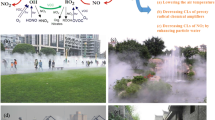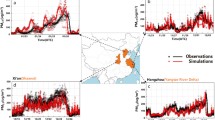Abstract
In the past 30 years, China has suffered from air pollution and heavy haze created by fast industrial growth and economic expansion. This article reviews the techniques for remediation of air pollution. Then, I propose a geoengineering method for mitigating air pollution and haze in China’s cities by using water to scavenge air pollution. Here, water should be sprayed into the atmosphere like watering garden. The scientific rationale and mechanism for the geoengineering scheme are explained. It is found that precipitation scavenging coefficients are very sensitive to the size distributions of both aerosol and raindrops, and rain intensity. I found that the water spray geoengineering method can reduce the PM2.5 pollution in the atmosphere very efficiently to 35 μg m−3 level in a very short time period from few minutes to hours or days, depending on the precipitation characteristics. In addition, the water spray geoengineering method has excellent advantages such as rapidity, already available technology, low cost, and a nature-like process. This proposed geoengineering scheme can be one of the answers for fighting air pollution in the cities globally.



Similar content being viewed by others
References
Andronache C, Gronholm T, Laakso L, Phillips V, Venäläinen A (2006) Scavenging of ultrafine particles by rainfall at a boreal site: observations and model estimations. Atmos Chem Phys 6:4739–4754
Chan CK, Yao X (2008) Review: air pollution in megacities in China. Atmos Environ 42:1–42
Crutzen PJ (2006) Albedo enhancement by stratospheric sulfur injections: a contribution to resolve a policy dilemma? Clim Change 77(3–4):211–220. doi:10.1007/s10584-006-9101-y
Intergovernmental Panel on Climate Change (IPCC) (2007) Climate change 2007: the physical science basis. In: Solomon S, Qin D, Manning M, Chen Z, Marquis M, Averyt KB, Tignor M, Miller HL (eds) Contribution of working group I to the fourth assessment report of the intergovernmental panel on climate change. Cambridge University Press, Cambridge, 996 pp
Ladino L, Stetzer O, Hattendorf B, Günther D, Croft B, Lohmann U (2011) Experimental study of collection efficiencies between submicron aerosols and cloud droplets. J Atmos Sci 68:1853–1864. doi:10.1175/JAS-D-11-012.1
Liu XG, Li J, Qu Y, Han T, Hou L, Gu J, Chen C, Yang Y, Liu X, Yang T, Zhang Y, Tian H, Hu M (2013) Formation and evolution mechanism of regional haze: a case study in the megacity Beijing, China. Atmos Chem Phys 13:4501–4514
Parrish DD, Singh HB, Molina L, Madronich S (2011) Air quality progress in North American megacities: a review. Atmos Environ 45(390):7015–7025. doi:10.1016/j.atmosenv.2011.09.039
Pruppacher H, Klett J (1997) Microphysics of clouds and precipitation, 2nd edn. Kluwer Academic, Boston, p 954
Seinfeld J, Pandis S (2006) Atmospheric chemistry and physics. Wiley, New York
Shao M, Tang XY, Zhang YH, Li WJ (2006) City clusters in China: air and surface water pollution. Front Ecol Environ 4(7):353–361. doi:10.1890/1540-9295(2006)004
Sisterson DL, Johnson SA, Kumar R (1985) The influence of humidity on fine-particle aerosol dynamics and precipitation scavenging. Aerosol Sci Technol 4:287–300. doi:10.1080/02786828508959056
Slinn W, Shen S (1970) Anisotropic Brownian diffusion and precipitation scavenging of submicron particles. J Geophys Res 75:2267–2270
Wang S, Hao J (2012) Air quality management in China: issues, challenges, and options. J Environ Sci 24(1):2–13
Yu SC (2000) The role of organic acids (formic, acetic, pyruvic and oxalic) in the formation of cloud condensation nuclei (CCN): a review. Atmos Res 53:185–217
Yu SC, Bi M, Lin X (1988) Preliminary investigation about natural sources of organic acids in the atmosphere and rain. Atmos Environ 4:36–40 (in Chinese)
Yu SC, Chen Z, Cai X, Chen X (1990) Preliminary study about the sources and causes of acid rain in Xiamen Island. Atmos Environ 5:43–44 (in Chinese)
Yu SC, Bi M, Lin X, Yao R, Tang X (1991) Organic acids in precipitation from Baiyun Mountain, Guanzhou and in cloudwater from Miaoer Mountain, Guangxi. Acta Sci Circumst 11(1):25–30
Yu SC, Chen Z, Cai X, Chen X (1992a) An investigation about chemical compositions of acid rain and their relationship with the meteorological conditions in Xiamen Island. Environ Prot Sci 3:68–73
Yu SC, Chen X, Chen Z (1992b) Organic acids in the oceanic acid rain of Xiamen Island. Shanghai Environ Sci 11(12):30–32
Yu SC, Chen Z, Cai X, Chen X, Shong W (1994a) A study of acid precipitation in the oceanic environment of Xiamen Island. Atmos Res 32:297–311
Yu SC, Chen X, Chen Z (1994b) Relationship between meteorological elements and acid rain and its sources at Xiamen Island. Meteorology 20(5):20–23
Yu SC, Gao C, Chen Z, Chen X, Chen S, Xiao J, Ye W (1998) An analysis of chemical composition of different rain types in “Minnan Golden Triangle” region in the southeastern coast of China. Atmos Res 47–48:245–269
Yu SC, Saxena VK, Zhao Z (2001) A comparison of signals of regional aerosol-induced forcing in eastern China and the southeastern United States. Geophys Res Lett 28:713–716
Yu SC, Kasibhatla PS, Wright DL, Schwartz SE, McGraw R, Deng A (2003) Moment-based simulation of microphysical properties of sulfate aerosols in the eastern United States: model description, evaluation and regional analysis. J Geophys Res 108(D12):4353. doi:10.1029/2002JD002890
Yu SC, Dennis R, Bhave P, Eder B (2004) Primary and secondary organic aerosols over the United States: estimates on the basis of observed organic carbon (OC) and elemental carbon (EC), and air quality modeled primary OC/EC ratios. Atmos Environ 38:5257–5268
Yu SC, Dennis R, Roselle S, Nenes A, Walker J, Eder B, Schere K, Swall J, Robarge W (2005) An assessment of the ability of 3-D air quality models with current thermodynamic equilibrium models to predict aerosol NO3 −. J Geophys Res 110:D07S13. doi:10.1029/2004JD004718
Yu SC, Mathur R, Schere K, Kang D, Pleim J, Otte TL (2007) A detailed evaluation of the Eta-CMAQ forecast model performance for O3, its related precursors, and meteorological parameters during the 2004 ICARTT study. J Geophys Res 112:D12S14. doi:10.1029/2006JD007715
Yu SC, Mathur R, Schere K, Kang D, Pleim J, Young J, Tong D, McKeen S, Rao ST (2008) Evaluation of real-time PM2.5 forecasts and process analysis for PM2.5 formation over the eastern U.S. using the Eta-CMAQ forecast model during the 2004 ICARTT Study. J Geophys Res 113:D06204. doi:10.1029/2007JD009226
Yu SC, Mathur R, Pleim J, Pouliot G, Eder B, Schere K, Wong D, Gilliam R, Rao ST (2012a) Comparative evaluation of the impact of WRF/NMM and WRF/ARW meteorology on CMAQ simulations for PM2.5 and its related precursors during the 2006 TexAQS/GoMACCS study. Atmos Chem Phys 12:4091–4106. doi:10.5194/acp-12-4091-2012
Yu SC, Mathur R, Pleim J, Pouliot G, Eder B, Schere K, Wong D, Gilliam R, Rao ST (2012b) Comparative evaluation of the impact of WRF-NMM and WRF-ARW meteorology on CMAQ simulations for O3 and related species during the 2006 TexAQS/GoMACCS campaign. Atmos Pollut Res 3:149–162. doi:10.5094/APR.2012.015
Yu SC, Mathur R, Pleim J, Wong D, Gilliam R, Alapaty K, Zhao C, Liu X (2013) Aerosol indirect effect on the grid-scale clouds in the two-way coupled WRF–CMAQ: model description, development, evaluation and regional analysis. Atmos Chem Phys Discuss 13:25649–25739
Acknowledgments
The author would like to thank Prof. Weiping Liu from College of Environment and Resources at Zhejiang University for his help and support. The author would like to thank Dr. Eric Lichtfouse for his comments and supports, and Dr. Theresa Foley for her help. This work is supported by the “Zhejiang 1000 Talent Plan.”
Author information
Authors and Affiliations
Corresponding author
Rights and permissions
About this article
Cite this article
Yu, S. Water spray geoengineering to clean air pollution for mitigating haze in China’s cities. Environ Chem Lett 12, 109–116 (2014). https://doi.org/10.1007/s10311-013-0444-0
Received:
Accepted:
Published:
Issue Date:
DOI: https://doi.org/10.1007/s10311-013-0444-0




